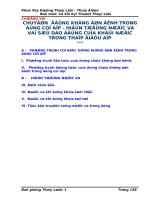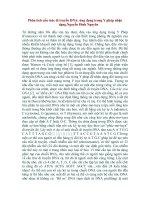Tài liệu Phân tích thuế_ Chương 8 pptx
Bạn đang xem bản rút gọn của tài liệu. Xem và tải ngay bản đầy đủ của tài liệu tại đây (555.51 KB, 71 trang )
Chapter 8
Fundamental Tax Reform
Public Finance and public Policy
Introduction
“The tax code today is nothing more than a
cesspool of legalized corruption and special interest
legislation. We should replace this monstrosity with
a simple flat tax for all Americans.”
Steve Forbes, during his 1996 presidential campaign.
His platform reflects some of the widespread
dissatisfaction with the current tax system.
Introduction
At certain times, this dissatisfaction has led to
action.
The 1986 Tax Reform Act reduced 15 tax brackets
ranging from 11% to 50% to just three ranging from
15% to 33%.
It lowered rates and taxed a broader base of income.
Subsequent legislation has added complexity to the
tax code, and greater opportunity for tax avoidance
and evasion.
Introduction
This final lesson discusses fundamental tax reform.
What are the motivations for moving to a low-rate,
broad-based tax system?
What are the political and economic barriers to such
reform?
What would be the effects of a consumption tax?
What are the effects of a flat income tax?
WHY FUNDAMENTAL TAX
REFORM?
There are three major arguments for fundamental
tax reform:
Increase tax compliance
Make the code simpler
Improve efficiency
Why fundamental tax reform?
Improving tax compliance
The first motivation for fundamental tax reform
relates to compliance.
Tax compliance
are efforts to reduce the evasion
of taxes.
Tax evasion
is illegal nonpayment of taxation.
This differs from tax avoidance, which are legal
means (such as giving to charity) to lower one’s tax
bill.
Tax evasion
Tax evasion
The distinction between evasion and avoidance is
sometimes a fine one, but it is not always the rich
who evade taxes.
For example, for many years taxpayers wanting to
claim tax exemptions for dependents were only
required to fill in their name on the tax form.
TRA 1986 also required the Social Security number
for dependents over age five.
6 million dependents suddenly disappeared.
A
ppl
ic
a
tio
n
A
ppl
ic
a
tio
n
Tax evasion
Tax evasion
In 1988, the tax law started requiring that the Social
Security numbers of child care providers be listed
before a worker could claim the child care credit.
2.6 million child care providers disappeared.
A
ppl
ic
a
tio
n
A
ppl
ic
a
tio
n
Why fundamental tax reform?
Improving tax compliance
The simplest theory of evasion weighs the marginal
benefits from underreporting $1 income (evasion)
against the marginal costs.
The marginal benefit is the saved tax.
The marginal cost is the marginal penalty per dollar
evaded, multiplied by the probability of getting
caught.
Figure 1
Figure 1 illustrates this.
50¢
Dollars
Evasion
MB
1
MC
1
E
1
MC
2
MB
2
E
2
E
3
60¢
Figure 1
Initially, choose evasion level
E
1
where MB
1
= MC
1
.
Increasing enforcement raises
the marginal cost and lowers
evasion. Evasion level E
2
where MB
1
= MC
2
.
Increasing tax rate raises the
marginal benefit and raises
evasion. Evasion level E
3
where MB
2
= MC
1
.
Why fundamental tax reform?
Improving tax compliance
In this case, as the marginal tax rate rises, the
marginal benefit curve shifts upward and more
evasion occurs.
As the expected penalty rises (either the penalty per
dollar or the probability of getting caught), the
marginal cost curve shifts upward and less evasion
occurs.
Why fundamental tax reform?
Improving tax compliance
The most recent evidence in the U.S. suggests that the “tax
gap” is $280 billion, or 16.3% of tax revenue.
In an interesting experiment, Slemrod, Blumenthal, and
Christian (2001) randomly sent letters to taxpayers before
taxes were due, either threatening audit or appealing to
people’s consciences to be honest.
The audit threats increased reported income for low and
middle income taxpayers.
They lowered reported income among upper class families,
who perhaps believed the letter was an opening round in a
negotiation, and their reported income was a “first offer.”
The 1997 IRS hearings
The 1997 IRS hearings
and their fallout for tax collection
and their fallout for tax collection
A
ppl
ic
a
tio
n
A
ppl
ic
a
tio
n
In September 1997, the Senate Finance Committee
held a week of hearings to investigate IRS abuses.
The committee heard all sorts of damning testimony,
much of which actually painted a skewed picture of
the IRS operations.
In 1998, President Clinton signed the “Taxpayer Bill
of Rights” which created some protections for
taxpayers.
The 1997 IRS hearings
The 1997 IRS hearings
and their fallout for tax collection
and their fallout for tax collection
A
ppl
ic
a
tio
n
A
ppl
ic
a
tio
n
As a result of this legislation, the IRS’s enforcement
capabilities have been severely impaired.
Number of field examiners fell by two-thirds.
Number of collection cases fell by one-half.
Number of evasion cases pursued fell by two-thirds.
Audit rates for self-employed fell from 4% to 2%.
IRS has identified $30 billion in underpayments, but
does not have the resources to pursue them.
The 1997 IRS hearings
The 1997 IRS hearings
and their fallout for tax collection
and their fallout for tax collection
A
ppl
ic
a
tio
n
A
ppl
ic
a
tio
n
Sentiment may now be turning in the opposite
direction, perhaps as a result of corporate scandals.
The latest IRS commissioner has vowed to make
enforcement a priority.
The damage may be done, because 17% of
Americans believe cheating on their taxes is
acceptable, up from 11% in 1999.
Why fundamental tax reform?
Improving tax compliance
Why should we care about tax evasion? Couldn’t
we raise taxes to offset this evasion?
First, such a policy would lower efficiency. Efficiency
is increased by broadening the base and lowering the
rates. Moreover, since cheating rises with higher
rates, it is partially self-defeating.
Second, evasion harms vertical equity, because upper
income households have greater scope for evasion.
Third, evasion is a very clear violation of horizontal
equity.
Why fundamental tax reform?
Making the tax code simpler
The second motivation for fundamental tax reform
relates to simplicity.
The IRS estimates that it takes 13-14 hours to
complete Form 1040, assuming most income came
from wages and there were no complicated
investment activities or itemized deductions.
Itemizing takes another 6 hours, and reporting small
business activity takes 11 hours.
Reporting capital gains is estimated to take 8 hours.
Why fundamental tax reform?
Making the tax code simpler
This complication motivates a simpler tax plan, such
as Steve Forbe’s flat-tax proposal.
This is illustrated in
Table 1
Table 1.
Table 1
Simplicity advantages of a flat tax
Current tax system Forbes’s flat tax
equals
Taxable income
minus
Deductions
minus
Exemptions
equals
Adjusted gross income (AGI)
equals
Taxable income
equals
Taxes owed
minus
Credits
equals
Total tax payment
minus
Withholding
equals
Final payment (refund) due
equals
Total tax payment
minus
Exemptions
minus
Itemized (or standard) deduction
Use income tax schedule Multiply by 20%
Gross income (wages, interest, etc.) Wage income
Forbes’s flat tax gets rid of the
tax deductions (“loopholes”) in
the current system, and lowers
the tax rate on most income.
Why fundamental tax reform?
Making the tax code simpler
Simplicity is an admirable goal, and often consistent
with other efficiency and equity goals.
Yet, some worthwhile goals are inconsistent with
such simplification.
For example including employer-provided health
insurance or pension contributions is consistent with
the Haig-Simons definition.
They substantially increase the reporting burden of
employers.
Why fundamental tax reform?
Improving tax efficiency
The third motivation for fundamental tax reform
relates to improving tax efficiency.
The cost of raising tax rates includes an entire array
of behavioral responses.
These include labor supply, savings, risk-taking, child
care use, and charitable giving.
The key question become how does changing the
tax rate change tax revenues? There are both direct
and indirect effects.
Why fundamental tax reform?
Improving tax efficiency
Direct effect of tax changes
means a higher tax
rate raises revenues on a fixed base of taxation.
Why fundamental tax reform?
Improving tax efficiency
The
indirect effects of tax changes
mean a higher rate
lowers the size of the revenue base on which taxes are levied.
These effects include:
Gross Income effect: The distortions discussed with respect to
labor supply, savings, etc.
Reporting effect: The incentives to reclassify income in ways that
are not subject to tax, such as providing employer health
insurance.
Income exclusion effect: The incentives to take greater advantage of
exclusions from gross income in defining taxable income, such
as 401(k) contributions.
Compliance effect: The increase in evasion.
Why fundamental tax reform?
Improving tax efficiency
Figure 2
Figure 2 shows an example of how tax revenue can
be affected by raising the tax rates.
Figure 2
Under the lower tax rate,
the individual takes more
of their compensation in
taxable income.
Under the higher tax
rate, the individual takes
some income in
deductible form, and
also evades.









